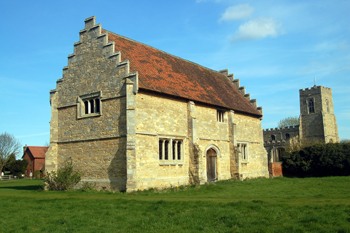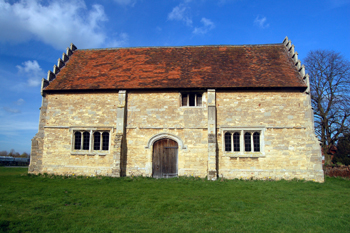Willington Stables

The stables three-quarter view with the church in the background April 2010
The stables, standing near Willington Dovecote and the church, are something of an enigma. They were listed by the former Department of Environment in July 1964 as Grade I, of exceptional interest. The stables originally belonged to the Manor House (now Manor Farm) and it has usually been considered that they were built, along with the dovecote, around 1539 or 1540 (to judge by the results of tree ring dating on timber from the property) by Sir John Gostwick. The structure is built of coursed limestone rubble with ashlar dressings, possibly reused from Warden Abbey which was dissolved in January 1537. King Henry VIII (1509-1547) visited Gostwick at Willington in 1541 as part of a royal progress.
As Treasurer and Receiver-General of the First-Fruits and Tenths, Gostwick was in a good position to benefit from the dissolution of the religious houses. The theory of the origin of the stonework rests in part on the fact that the manor house was built of wood and brick and there is no stone in the locality for building. The construction of two such substantial buildings as the dovecote and the stables in good quality stone suggests a sudden windfall of material. The theory is boosted by the fact that corbel stones and fragments of re-used glazed floor tiles, such as would have been used in a religious structure have been identified in the building materials.
![Close-up of the church dovecote and stables on the Russell Estate map of 1779 [R1/75]](/CommunityHistories/Willington/WillingtonImages/Close-up of the church dovecote and stables on the.jpg)
Close-up of the church dovecote and stables on the Russell Estate map of 1779 [R1/75]
In 1849 Lord of the Manor, the Duke of Bedford, wanted to pull down the dovecote and stables and erect modern farm buildings to serve Manor Farm. The minutes of The Bedfordshire Archaeological Society [X69/16] reported the matter thus: "The Revd. H. E. Havergal [Henry East Havergal, Vicar of Cople] brought before the meeting the subject of the proposed destruction of the interesting buildings on the farm of Mr. Purser at Willington, to make room for new farm buildings”.
“A discussion took place upon this subject and at length the meeting resolved to memorialize the Duke of Bedford, the owner of the property, to spare the buildings. The Council were thereupon requested to prepare the memorial and forward to His Grace”.
At the meeting on 18th December 1849 it was minuted: “A memorial to His Grace the Duke of Bedford on the Willington outbuildings was offered to the Society for revision and the Rev. H. J. Rose was requested to revise it”.

The stables side view April 2010
On 19th March 1850 it was recorded: “Letters were read from Mr. Martin, Librarian to the Duke of Bedford written by order of His Grace acknowledging the memorial of the Society and stating that His Grace’s attention had already been drawn to the Remains at Willington, that the Stables and Dovecote are sound but the Barns are in a dangerous state”. Thus the Duke agreed to spare both buildings. In 1946 Isaac Godber of Manor farm, the owner, considered converting the stables into an agricultural cottage. This proved impracticable and he donated it to the National Trust in 1947, the Trust already owning the dovecote [CRT130Willington7].
The stables has external dimensions of 63 feet by 35 feet. The main entrance is on the west wall but two blocked up doors can be seen on the east wall. The substantial character of the stables has led to the suggestion that it was designed as a good quality house. The Victoria County History for Bedfordshire published in 1912 (Volume III, page 262) comments: "the only remains of which [Gostwick's manor house] now standing being a rectangular stone-brick building of c. 1520, in two stories, with stepped gables at either end. It is now used as a stable, but its moulded ceiling beams and good arched fireplace on the first floor show it to have been a living place of good quality in its best days". Running against this idea is the fact that the building stood amongst other farm buildings and had no staircase to the first floor, only a ladder.
Architect John Manning and former County Archivist Joyce Godber wrote an article on the stables which explored the contradictory evidence of the building [CRT130Willington9]. They noted: "The fact that the building is so large and so finely built suggests that it was built for domestic purposes, a suggestion supported by the large windows to the ground floor. With glass in the windows, this floor would hardly have been usable as a stable, owing to condensation and lack of air". They observed that the style of the windows was more late 15th century than 16th, though the stepped gables were a Tudor feature. The presence of lath nails in the joists indicate that the ground floor had a plastered ceiling and the writers sugegsted that a staircase could have fitted into the area where the ladder later stood. These two facts, they argue, suggest a dwelling later converted to a stables. They concluded that the building may perhaps have been built as a small manor house in the late Middle Ages and that this building was replaced by Gostwick's manor house, now Manor Farm. They also suggested that he altered the building to form a stables and that his steward may have lived in some of the rooms on the first floor.
In 1998 in Volume 26 of The Bedfordshire Magazine Dorothy Jamieson, local historian and expert on Willington wrote that modern techniques had been used to date the timbers in the stables to the early 16th century, tying the building in with Sir John Gostwick, though, she pointed out, he may have only enlarged an existing building, instead of building from scratch. She emphasised that no evidence exists to determine the original use of the building, whether it was built as a stables or as something else and converted later.

The stables, church and dovecote in November 2006